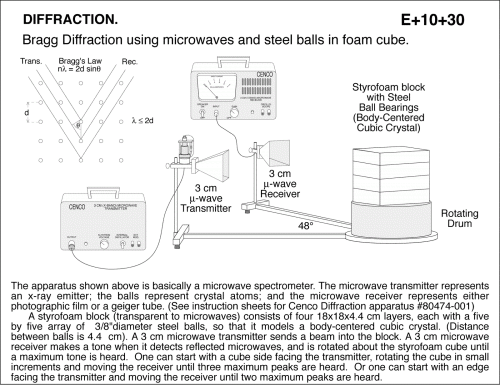Bragg diffraction using microwaves and steel balls in foam cube.
Primary tabs
Bragg Diffraction using microwaves and steel balls in foam cube. The apparatus shown above is basically a microwave spectrometer. The microwave transmitter represents an x-ray emitter; the balls represent crystal atoms; and the microwave receiver represents either photographic film or a geiger tube. (See instruction sheets for Cenco Diffraction apparatus #80474-001) A styrofoam block (transparent to microwaves) consists of four 18x18x4.4 cm layers, each with a five by five array of 3/8"diameter steel balls, so that it models a body-centered cubic crystal. (Distance between balls is 4.4 cm). A 3 cm microwave transmitter sends a beam into the block. A 3 cm microwave receiver makes a tone when it detects reflected microwaves, and is rotated about the styrofoam cube until a maximum tone is heard. One can start with a cube side facing the transmitter, rotating the cube in small increments and moving the receiver until three maximum peaks are heard. Or one can start with an edge facing the transmitter and moving the receiver until two maximum peaks are heard.
UCB Index:
E+10+30
PIRA Index:
7A60.50
UCB Taxonomy:
PIRA Taxonomy:
Popularity:
Previous:
- Log in to post comments

